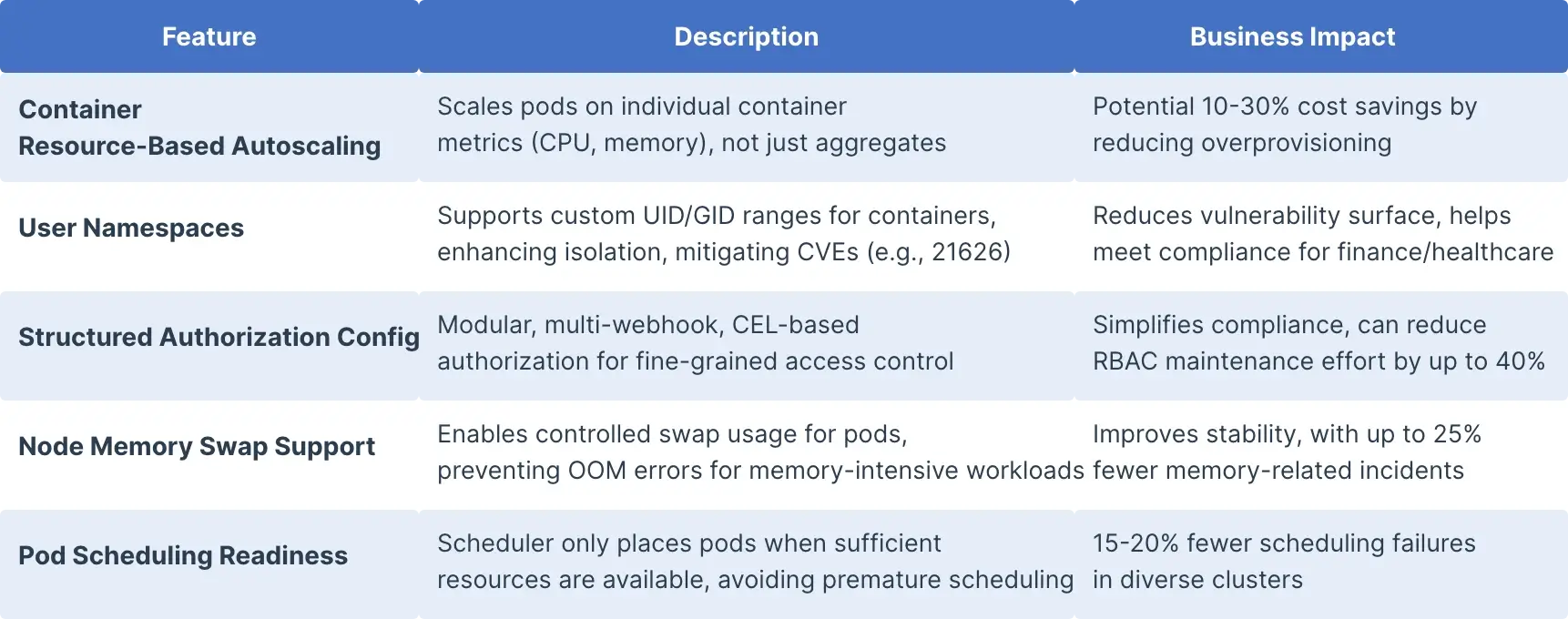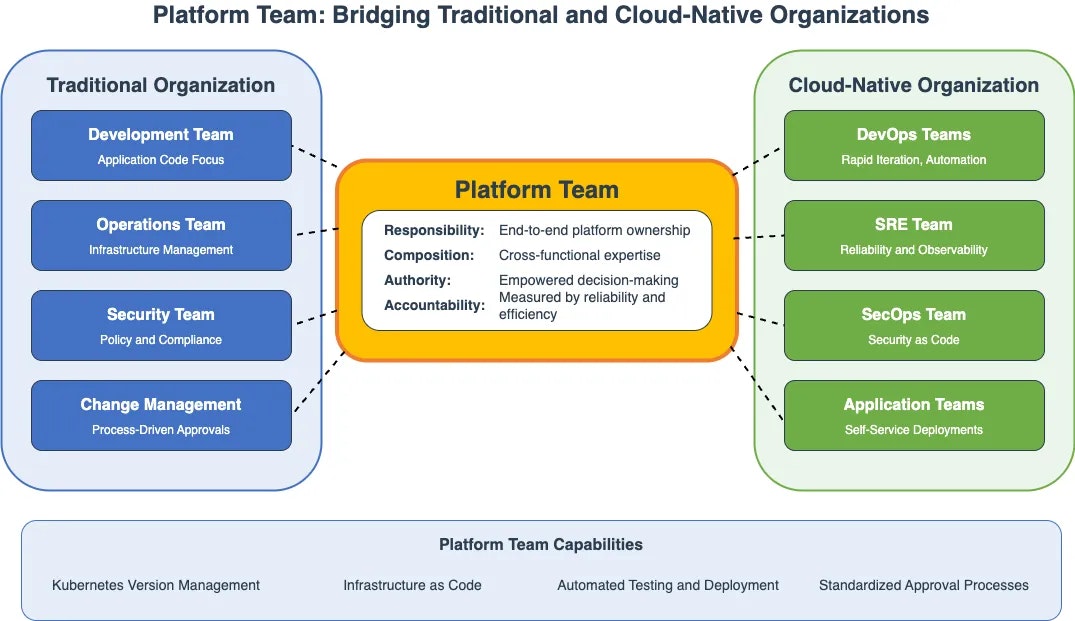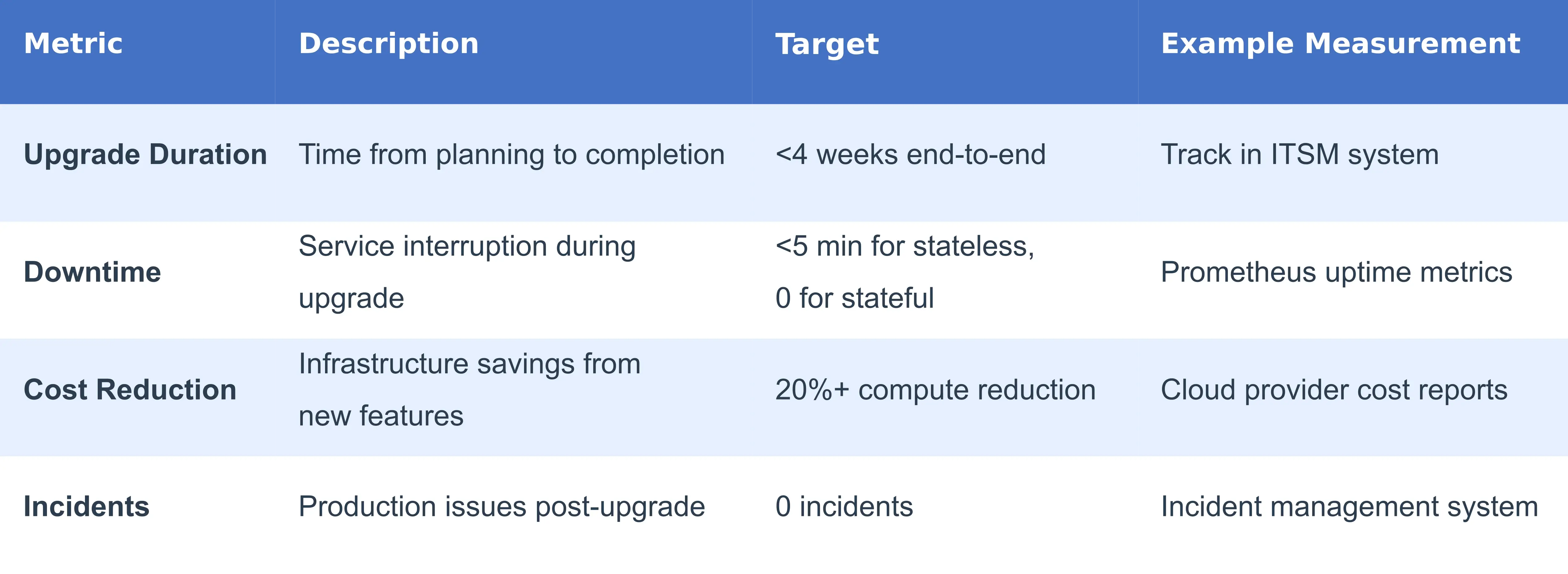Introduction
In today's enterprise environments, particularly those with traditional IT governance structures, Kubernetes version upgrades often become lengthy, resource-intensive projects spanning six months or more. What should be a routine operational process becomes a major undertaking that drains resources, creates organizational friction, and diverts focus from innovation.
This strategic guide outlines Kubernetes upgrade best practices that help IT leadership transform upgrades from lengthy projects into routine, streamlined processes.
Why Kubernetes Upgrades Become Projects
Before exploring solutions, it's essential to understand why Kubernetes upgrades grow into full-scale projects:
Versioning Pressures and Support Timelines
Cloud providers maintain different support windows for Kubernetes versions, but they all follow a similar pattern: standard support periods followed by extended support at premium rates. For Amazon EKS, clusters are automatically upgraded to prevent security vulnerabilities after both standard and extended support periods end. This creates natural pressure points that drive upgrade cycles.
Organizational and Governance Friction
This disconnect is particularly pronounced in enterprises with traditional IT governance, where:
- Organizational Siloing: Development, operations, security, and compliance teams often operate independently with limited collaboration
- Complex Approval Processes: Multiple signoffs across different departments create bottlenecks
- Risk-Averse Culture: Strong preference for established practices over innovation when stability is at stake
- Documentation Requirements: Extensive documentation requirements for audit and compliance purposes
The Cost of Slow Upgrades
The real impact of treating Kubernetes upgrades as major projects manifests in several ways:
- Direct Costs: Extended support fees ($0.60/cluster/hour vs. $0.10/hour for standard support on EKS)
- Opportunity Costs: Dedicating engineering resources to lengthy upgrade projects instead of innovation
- Security Risks: Increased vulnerability exposure on older versions
- Feature Delays: Missing out on new capabilities that could reduce operational costs
- Technical Debt: Delayed upgrades make future upgrades more complex and risky
For a medium-sized enterprise with 20 EKS clusters, extended support alone can incur an additional annual cost of $87,600, plus opportunity costs and associated risks.
The Business Case
Key Features Worth Upgrading For
The Transformation Framework
Transforming upgrades requires cultural change, standardized processes, and cost-efficient technical strategies. Here's how to approach it:
1. Cultural and Organizational Change
The need for frequent, incremental updates to Kubernetes often clashes with traditional approaches to change management. The key to success is building a bridge between these worlds:
Creating a Platform Team
A dedicated platform engineering team becomes the foundation of effective Kubernetes lifecycle management, ensuring seamless version upgrades and platform reliability:
- Responsibility: End-to-end ownership of the Kubernetes platform lifecycle
- Composition: Cross-functional team with development, operations, and security skills
- Authority: Empowered to make version decisions and implement upgrades
- Accountability: Measured on platform reliability and upgrade success
This approach addresses the siloed team structures common in traditional organizations by creating a team with shared goals and complementary skills.
Standardized Approval Workflows
Traditional change management requires extensive planning and multiple approvals, but this can be standardized and streamlined:
Organizations can balance governance needs with operational agility by creating pre-defined change types with clear approval paths.
Internal Developer Platform Approach
Abstracting Kubernetes complexity from application teams creates a clean separation of concerns:
- Application teams can focus on building and deploying applications
- Platform teams manage Kubernetes versions and infrastructure
- Standard interfaces mask infrastructure complexity
- Versioning becomes transparent to application developers
2. Defining Success Metrics and Goals
To transform Kubernetes upgrades from projects to processes, you need clear metrics to track progress:
The objective is to make upgrades predictable, low-risk, and efficient, allowing your organization to:
- Stay within standard support periods
- Rapidly adopt security patches
- Leverage new features for operational improvements
- Minimize the engineering time spent on upgrades
3. Strategic Rollout Patterns
Choosing the right approach to upgrades is critical for minimizing business risk:
Decision Tree:
- If downtime is unacceptable → Blue/Green deployment
- If thorough testing is a priority → Canary deployment with 10-20% traffic
- If cost is a concern → Rolling updates with PDBs
- If organizational confidence is low → Phased approach starting with development environments
4. Cost Optimization Strategy
Kubernetes upgrades provide significant opportunities for cost optimization:
Extended Support Avoidance
- Standard support: $0.10/cluster/hour
- Extended support: $0.60/cluster/hour
- Annual difference: ~$4,380 per cluster
Resource Efficiency with New Features
- Container Resource-Based Pod Autoscaling can reduce compute costs 10-30%
- Pod Scheduling Readiness improves resource utilization
- Node Memory Swap Support reduces instance size requirements
Operational Efficiency Gains
- Automated upgrades reduce labor costs
- Standardized processes decrease coordination overhead
- Fewer incidents means less firefighting
A typical organization can anticipate total cost savings of 20-40% through an effectively executed Kubernetes upgrade strategy, considering both direct and indirect expenses.
5. Risk Mitigation Approach
Organizations with strong risk aversion require additional measures to build confidence:
Comprehensive Rollback Plans
- Document detailed rollback procedures for each upgrade step
- Implement automated rollback mechanisms
- Test rollback procedures in non-production environments
Stakeholder Communication
- Create standardized upgrade reporting templates
- Schedule pre-upgrade briefings and post-upgrade reports
- Share metrics dashboards with leadership
- Integrate upgrade plans and results in enterprise systems
Incremental Confidence Building
- Run canary tests for 2+ weeks and present detailed metrics to management before production upgrades
- Create a "trophy case" of successful upgrades with metrics showing improvements
- Document cost savings to demonstrate business value
Implementation Roadmap
Here's a phased approach to transforming your Kubernetes upgrade strategy:
Phase 1: Assessment and Planning (1-2 months)
- Inventory current Kubernetes environments and versions
- Document current upgrade processes and pain points
- Define success metrics and targets
- Build a business case with projected ROI
- Identify platform team candidates
Phase 2: Foundation Building (2-3 months)
- Establish a platform team structure and responsibilities
- Implement Infrastructure as Code for all clusters
- Create standardized upgrade patterns and documentation
- Define change management templates and approval workflows
- Develop an automated testing framework
Phase 3: Pilot Implementation (1-2 months)
- Select pilot clusters for the initial transformation
- Implement new processes in non-critical environments
- Measure results against success metrics
- Refine the approach based on learnings
- Document successes and challenges
Phase 4: Enterprise Rollout (3-6 months)
- Scale approach to all Kubernetes environments
- Train teams on new processes and tools
- Integrate with enterprise systems (ITSM, monitoring)
- Establish a regular upgrade cadence
- Implement a continuous improvement feedback loop
Conclusion: Building a Competitive Advantage
Transforming Kubernetes upgrades from major projects into routine operational processes isn't just about reducing costs—it's about building a competitive advantage through:
- Greater Agility: Faster adoption of new features and capabilities
- Enhanced Security: Rapid deployment of security patches and updates
- Resource Optimization: Freeing engineering talent for innovation
- Cost Efficiency: Reducing both direct and indirect upgrade costs
The most successful organizations treat Kubernetes upgrades not as one-off projects but as part of a continuous improvement cycle with the following:
- Regular, predictable upgrades (typically every 6 months)
- Consistent patterns that are refined with each iteration
- Thorough documentation and knowledge sharing
- Metrics that track improvement over time
By making Kubernetes upgrades business-as-usual and adopting a proactive EKS version upgrade strategy, enterprises can reduce costs, enhance security, and maintain a competitive edge.
Ready to move from project-based upgrades to true operational excellence?
Learn how to implement the technical best practices in Part 2: Technical Guide.
Book a Demo or Contact Us to start streamlining your Kubernetes upgrades.




